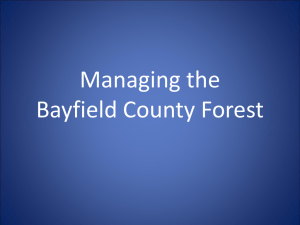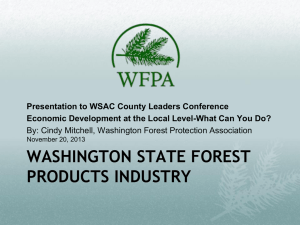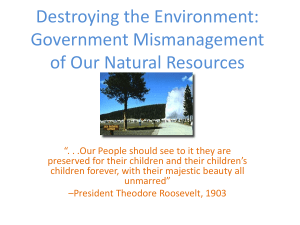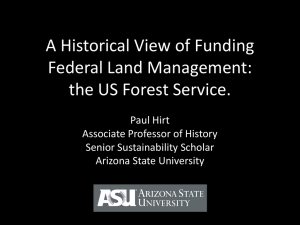Items to Know in the Field: Collaborating with DOF
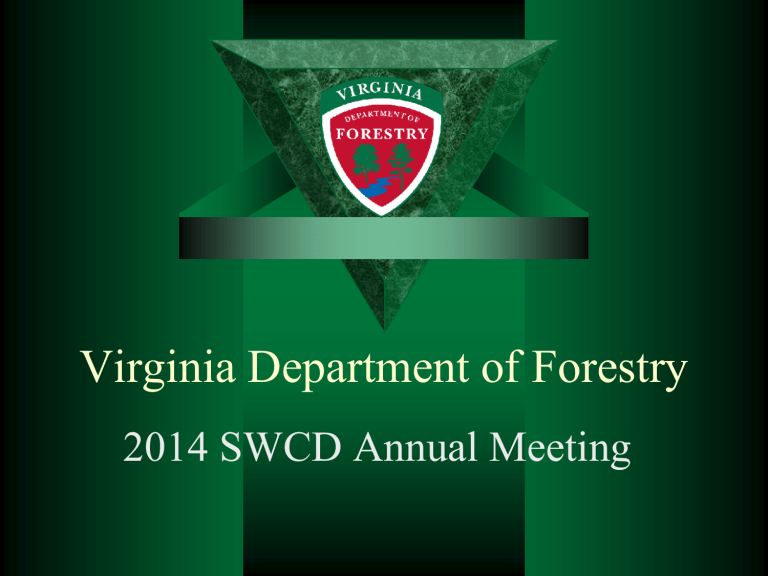
Virginia Department of Forestry
2014 SWCD Annual Meeting
VDOF Mission:
“We protect and develop healthy, sustainable forest resources for
Virginians”
Our goals in Virginia:
DOF has ~250 employees to meet the following goals:
Protect the Forest Resource from Wildfire, Insect and Disease, and other Natural Disasters
Conserve the Forest Land Base
Protect Water Quality
Improve and Renew Forest Resources
Protecting Our Forests -Wildfire
Agency relies on a fleet of:
– 190 – 4X4 Pickup truck-based engines
– 7 – specially equipped Hummers
– 5 – Custom designed wildland brush trucks
– 89 bulldozer/wildland fire plow suppression units
– 2 – Incident Command Vehicles
– 1 - Airplane
Protecting Water Quality
Harvest Inspection
Program
-Notification Law
Law Enforcement
-Silvicultural Water
Quality Law
Education
-Sharp Logger
Program
Protecting Water Quality
Assist Federal Agencies with
Riparian Forest Buffer Est.
-CREP, CRP, EQIP, VABMP
Riparian Buffer Tax Credit
Riparian Buffer Tax Credit
(RBTC) Riparian Buffer
Tax Credit
Tax Credit through the Virginia General Assembly
Eligibility includes individuals, & S-Corporations or Family Partnerships.
Leaving existing buffers along waterways during a timber harvesting operation
Requirements include a Forest Stewardship Plan,
35’+ wide buffer, and be retained for 15 years after harvest
Credit is 25% of value of timber up to $17,500
Cost is $150 per application
Improve and Renew Forest
Resources – starts with a plan
If you own a tract of timberland (regardless of size), you should have some type of plan for the future.
For small tracts (1-50 acres) - a simple one page letter and a map may be enough.
For larger tracts, (50-1000+ acres) – landowners should have a detailed Forest
Management Plan.
Forest Management Plans should:
List landowner objectives
Divide the tract into parcels based on timber type and age and make recommendations for each one
Should address timber, wildlife, endangered species, invasive species, soil types, water quality, and historical sites
Forest Management Plans should:
Include a timeline that tells you what year certain practices need to be done
Include a detailed map
Include Consulting Forester, Timber Buyer, and Logger lists if timber harvesting was recommended in the plan
Forest Management Plans
VDOF – Forest Stewardship Plans for $1.50
/acre or $200 minimum
Consulting Foresters – Forest Stewardship,
Tree Farm, or Conservation Activity Plans
(CAP 106 Plan) for a fee
Landowners can receive cost share assistance money from the NRCS for the
CAP 106 Plans.
Other Benefits
A current Forest Stewardship is required for the following:
-Riparian Buffer Tax Credit
-Before harvesting timber on tracts that have a conservation easement
Other Benefits - continued
If you are applying for cost share funding through NRCS’s EQIP program, you will receive extra points for practices that were recommended in the plan.
Sustainable Forestry
Regenerating a forest ASAP following a timber harvest (planting or natural regen)
Minimizing the impact of forest management activities on water quality
Maintaining important habitat elements for wildlife and plant species
Protecting forests with high conservation values
Sustainable Forestry
Maintaining biological diversity
Limiting the spread of exotic (non-native) plant species and pests
-tree-of-heaven
-kudzu
Foresters biggest challenge: preventing diameter limit cuts
Many landowners think that clear-cutting is bad.
Loggers may tell them that this is “Sustainable Forestry”
Young yellow poplar stand
-started from a clear-cut
Both stands started from a clear-cut (20/70 years ago)
Deferment cut
Pine Management – Why are we planting pine trees?
Cheap to establish – $75/acre to plant around 500 trees per acre (seedlings and labor). Cost share programs to assist with costs of establishment and management.
Thin or total harvest in 20-30 years
Current FIA data shows that more pine is being harvested than we are growing/year.
Loblolly plantation
3 yr old/20 yr old (thinned)
Cost Share Programs:
VDOF – RT Program
2014-2015 Program Year
-$25/acre - tree establishment – LLP
-$48/acre - establishment – SLP, PxL
-$70/acre for site prep (chemical)
-$22/acre for herbicide release (air)
-$45/acre for herbicide release (backpack)
Cost Share Programs:
NRCS – EQIP Program
2015 Program Year
-$60-70/acre - tree establishment
-$70-90/acre for site prep (chemical)
-CAP 106 Plans – $625-$5300
-Riparian Buffer Est - $670-$1600
RT vs. EQIP
RT – simple to sign up, approve signups until we run out of $$, individual counties have their own allotment, can be used for only one practice
EQIP – can be used for multiple practices over multiple years, payment rates are higher,
Questions?

